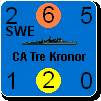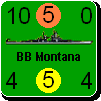Shannon V. OKeets
Posts: 22095
Joined: 5/19/2005
From: Honolulu, Hawaii
Status: offline

|
quote:
ORIGINAL: Larry Smith
How about limiting the stacking in a hex. One less corps/army. If you think about it, the Pacific map was twice the scale of the European map. Yet this just means that the front per hex on the PacMap is twice as long, and hence should have had twice the stacking of the European hexes (not four times, as one might think if considering the increase in area). Yet, the stacking on the PacMap was the same as the European map. If you think about the logistical difficulties both sides had in the theatre, the limit makes sense.
Now, you've blown up the PacMap to the same scale as the European map, the stacking should decrease to keep in line with what was present before (ie: the PacMap had half the troop density along the front lines).
One could always allow the stacking of an extra corps (ie: to EurMap limits) in and around cities (just for whomever controls the city). The excuse could be thataround the city there are more and better roads, and the local civilian population has been partially conscripted for logistical support by whomever controls the city. Thus the Japanese player would have a hard time as he is limited to 1 corps and 1 div per hex, but the Chinese controlling, say, Changsha, could have up to two corps and a division in the city and the hexes around it. This forces the Japanese to carefully plan his assaults. As the cities would often interfere with rail transportation of resources, there'd be no point in investing the force to sieze and hold said resources if they cannot be transported. The Japanese would need armour to strip away the defenses around a city before assaulting it directly. Once ensconced in the city, the Chinese would (what with the stacking limit now applying to them, plus their weaker units) not likely be able to mount an offensive to retake the cities. Finnally, combine that with a 1 hex reduction in the supply range of units in the Pacific (and not tracing from a rail line or a city), and suddenly, Chingking is out of reach without investing a considerable force. Could you see the Japanese player, limited to 1+1 stacking trying to take Kunming, which would have 2+1. This would also help the ChiComs hold onto Sian.
If you can keep the relative stacking (per two hexes) the same, I believe it would help. More than 1 hex from a controlled city, both sides would be under the same limit, so the relative force per hex would remain the same. A final note, I'd suspend this limit for the US. They did have a superior logistics system. Also, should the US player take the time to liberate China, the Japanese would be mostly OOS.
Larry,
There are a lot of things taken into considerationwhen creating a game. You have mentioned several of them in this post. There are dozens more (integrated artillery, officer training, volunteers/drafted soldiers versus career soldiers, ...). I do not know what ADG took into consideration when they created WIF. At this point, I am not in a position to revisit all of their decisions in regard to stacking limits. Rather, my task is to implement the WIF FE. In doing so, I have agreed with (and strongly support) the decision made back in 1996 to have one map with a unified scale. In accordance with that decision, I am also simply applying the WIF FE stacking limits for the European map to the rest of the world.
As you can see from your own analysis of what should be considered when designing stacking limits, it neither simple nor straightforward. To undertake a revision to this fundamental element of the game design is "out of task" for my job description.
_____________________________
Steve
Perfection is an elusive goal.
|
 Printable Version
Printable Version











 New Messages
New Messages No New Messages
No New Messages Hot Topic w/ New Messages
Hot Topic w/ New Messages Hot Topic w/o New Messages
Hot Topic w/o New Messages Locked w/ New Messages
Locked w/ New Messages Locked w/o New Messages
Locked w/o New Messages Post New Thread
Post New Thread